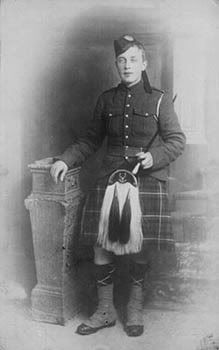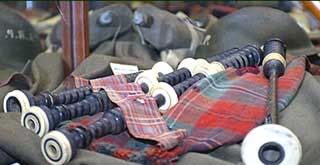|
myOtaku.com
• Join Today!
My Pages
• Home
• Portfolio
• Guestbook
• Quiz Results
Contact Me
E-mail
• Click Here
OtakuBoards
• SomeGuy
Vitals
Birthday
• 1983-08-05
Gender
•
Male
Location
• Vancouver, BC
Member Since
• 2003-08-02
Occupation
• Writer; Part-Time Hero
Real Name
• James
Personal
Achievements
• Visiting eight different myO friends in person thus far
Anime Fan Since
• Winter 2001
Favorite Anime
• Neon Genesis Evangelion, .hack//SIGN, Naruto, Bleach, Beck, Peacemaker Kurogane, Ranma 1/2 (the guilty pleasure)
Goals
• Visit the myO friends I've missed thus far; complete a cosplay from 300
Hobbies
• Writing, Gaming, Kung Fu, Movies, Acting somewhat strange in general
Talents
• Can recognise most quotes from almost any movie/show on first listen; Can recite the entire 12 days of Christmas by memory
|
|
|
Thursday, November 8, 2007
Piper James Cleland Richardson, VC (1895-1916)
While Yashka Bochkareva may be a kind of folk hero for the Russian people, it turns out I've got one from quite close to home. This is a tale of valour that stretches for 80 years. This is the tale of Piper James "Jimmy" Cleland Richardson, who's immortalised by a bronze statue outside City Hall in Chilliwack, BC (about an hour's drive east of Vancouver).
Originally born in Lanarkshire in Scotland, James Richardson moved to Vancouver with his family in 1913. While there, James joined the Vancouver 72nd Battalion Seaforth Highlanders Cadet Corps Pipe Band. His father went on to become Chief of Police in the city of Chilliwack and the family moved there - James likely remained in Vancouver, but was still active in various Chilliwack functions, piping at special functions. On July 1st, 1914, he won three first-place awards for piping in a bagpipe competition during the Scottish Sports Day event in Victoria, BC.
When war broke out in 1914, Richardson went with the Seaforths - which became part of the 16th Scottish Battalion - as part of the Canadian Expeditionary Force.
His unit, the 16th, fought at The Battle of the Somme in 1916. On October 8th, they were tasked with capturing a stretch of trench codenamed "Regina Trench"; it would not be an easy task. Once the whistle blew for the men to go over-the-top, they were caught in extensive barbed wire and extremely heavy gunfire; the 16th was stuck. Further, a great deal of the company's leadership was dead or wounded. Piper Richardson took it upon himself to turn the tide:
"Suddenly the whole scene changed. Young Richardson took in the situation. Danger seemed to stimulate and accentuate the Scotch intellect. For some reason he hadnít been allowed to play up to this point. Turning to the sergeant-major in the shellhole beside him, he said, 'Will I gie 'em wind?' 'Aye mon, gie 'em wind,' was the laconic reply. Good God! Look at that! There was a young, smooth-faced boy coolly playing up and down the wire in that hail storm of lead."
(Colonel C.W. Peck, V.C., D.S.O. and Bar)
Piper Jimmy Richardson began marching back in forth in front of the barbed wire, piping loud over the din of the surrounding battle, without visible concern for the bullets flying around him. It did the trick, and his now-inspired battalion rushed the wire and captured Regina Trench.
For that action, Richardson would be awarded the Victoria Cross: the highest honour a soldier in the Commonwealth can acheive for valour.
Later that day (or on the next day), Richardson was ordered to take a wounded soldier and a group of prisoners to the rear. At some point during his escort, he realised that he had left his pipes behind at the front and went back to retrieve them . . . and that was the last time he (or his bagpipes for that matter) was ever seen. He was 20 years old when he disappeared to the mud of war and the mists of time.
With that said, his Victoria Cross was awarded posthumously to his parents in Chilliwack, who displayed the medal in a store window for years . . . but the story doesn't end there . . . . .
In 2002, almost 90 years later, Pipe Major Roger McGuire of the Canadian Scottish Regiment (The Princess Mary's) responded to an internet posting asking for help in identifying an unfamiliar tartan (the Scottish colour-pattern) on a set of World War I bagpipes . . . McGuire was quick to recognise the pattern as the Lenox Tartan of the 16th Battalion!
It turned out that in 1917 a British Army Chaplain, Major Edward Yeld Bate, found the pipes in the mud of The Somme and brought them back to Ardvreck School in Crieff, Scotland where he worked as a teacher before the war. For the next 80-odd years the school took care of the pipes as a reminder of the war and for this one forgotten piper. Further research by McGuire and others into locations and times soon identified these pipes as the very ones played by Jimmy Richardson back in October of 1916.
The Canadian Club of Vancouver purchased the pipes from Ardvreck School on behalf of Canada; in 2006, Richardson's bagpipes were repatriated to British Columbia and are now on public display in the rotunda of the British Columbia Legislature in Victoria.
As for his family's hometown of Chilliwack, a life-sized bronze statue of Richardson was commissioned and created in 2003; it now stands - as I first mentioned - in front of City Hall.
Richardson's tombstone itself is in the Adanac Military Cemetery in France.
Imagine what it must've been like for Piper Richardson to do what he did that day. Marching back and forth in plain site with machine guns trained in his direction, unarmed, and playing one of the loudest, most recognisable instruments in the history of the world. It almost feel unbelievable that such a thing can actually happen in the real world . . . and yet it did.
Such is the nature of valour, I guess. If anyone could do it, then we wouldn't need heroes, would we?

(Photo of Piper James Cleland Richardson, VC)

(The famous bagpipes as they're displayed today)
Comments
(4)
« Home |
|